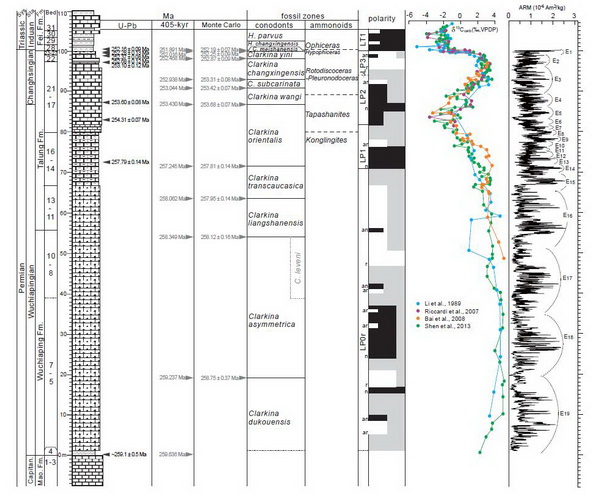The Lopingian is the uppermost series of the Paleozoic and it is bracketed by two major biological events – the pre-Lopingian crisis and the end-Permian mass extinction (EPME). It also records the most dramatic environmental changes during the Phanerozoic. A high-resolution temporal framework is essential to understand the patterns and causes of the extinctions.
Lopingian strata of South China have been intensively studied because three GSSPs have been defined by the FADs of conodont species in the region. In addition, as the most important fossil group for Lopingian biostratigraphy, conodonts are selected as the international standard to recognize boundaries and to correlate stratigraphy. Thus, a high-resolution conodont succession for the Lopingian strata from South China is vital to establish an integrative timescale.
Recently, Dr. Dongxun Yuan from Nanjing Institute of Geology and Palaeontology, Chinese Academy of Sciences updated the integrative timescale, including biostratigraphy, chemostratigraphy, magnetostratigraphy, cyclostratigraphy and geochronology, for the Lopingian (Late Permian) based on results from newly-collected samples from the uppermost Guadalupian to the lowest Triassic at the Shangsi section, South China.
The entire Lopingian high-resolution conodont succession was for the first time, since the Lopingian Series was adopted as the international standard, recognized at a single section in South China and the succession correlated very well with the Lopingian GSSP sections at Penglaitan and Meishan. The conodont succession was also temporally calibrated by geochronologic ages, identified 405-kyr eccentricity cycles, and a Monte Carlo analysis. The framework provided the possibility that the current high-resolution marine international standard can be correlated with nonmarine strata by means of magnetostratigraphy and cyclostratigraphy.
The study also adopted the Unitary Associations approach to establish unitary association zones (UAZs) and test these conodont biozones based on seven important Lopingian sections of South China. The main contradictions between UAZs and biozones, especially at the PTB interval, were discussed, and the correspondence between UAZs and biozones of the Shangsi section provided a practical example to understand controls on conodont UAZs. The PTB of the Shangsi section was constrained in view of ammonoids, bivalves, conodonts, U-Pb ages and mass extinction event, and updated ages for the base of the Lopingian and base of the Changhsingian were provided.
Reference: Yuan D.X.*, Shen S.Z., Henderson C.M., Chen J., Zhang H., Zheng Q.F., Wu H.C., 2019. Integrative timescale for the Lopingian (Late Permian): A review and update from Shangsi, South China.Earth-Science Reviews, 188: 190-209. DOI: https://doi.org/10.1016/j.earscirev.2018.11.002.

Exposure of the Shangsi section and outcrops showing the PTB interval

Lopingian stratigraphic framework at the Shangsi sect
